Are Tech Workers Coming Back To California? – Bay Area Housing Market Updates
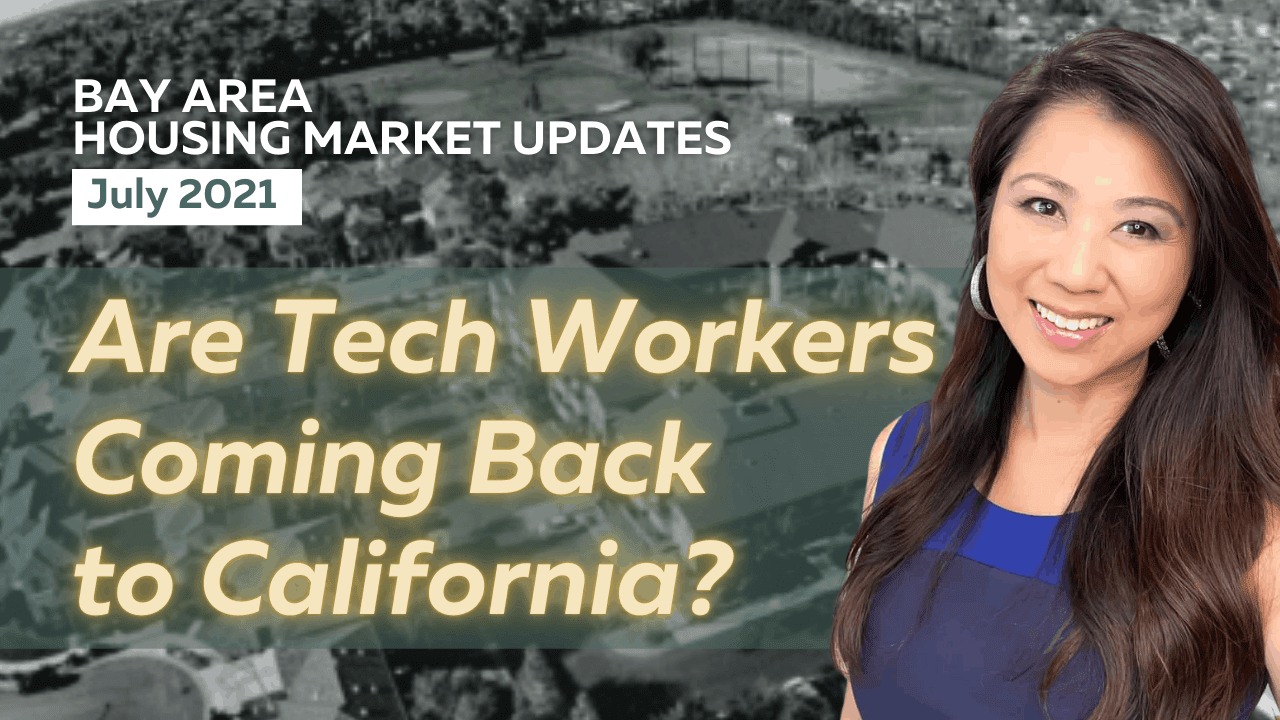

Welcome to our July 14 Housing Market Updates from Bay Area Housing Market Townhall Webinar! Today, we’re going to talk about the Bay Area housing market. We also want to look at where the mortgage rates are going, and one of the biggest topics people have been talking about – are people coming back to California? Or are they staying out? We’re going to look at the job market, we’re going to look at the office leasing activities. Of course, we have to look at the rental market as well with the eviction moratorium update, the rent rates, and the occupancy. Watch the video recording here!
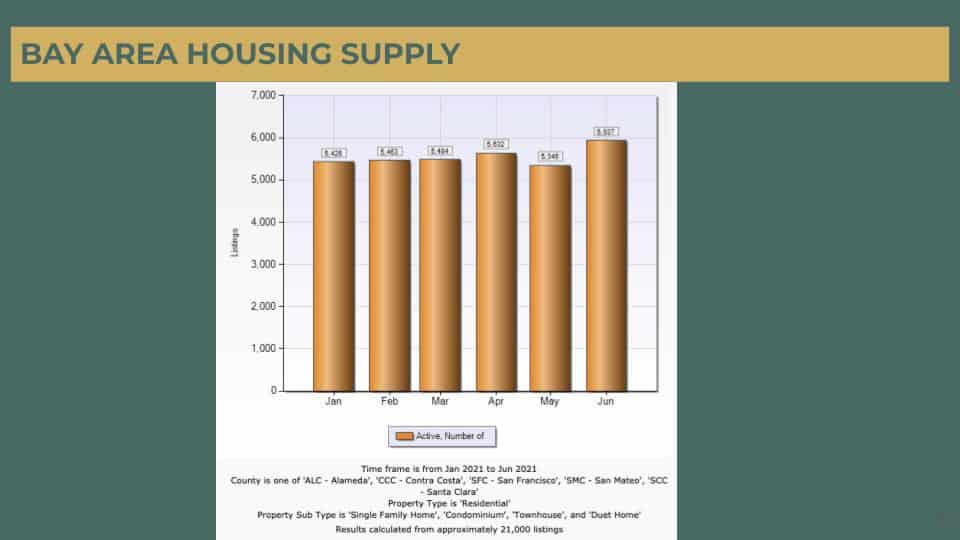
Now, let’s start with our Bay Area housing market. I thought I would share with you the data for the number of active listings since January of this year. As you see, it may not look like it fluctuates a lot, but really, from May to June, the number of listings jumped up over 10%. Actually, back in May, we talked about how we would start seeing inventory go up, and we definitely have seen it in June. We also noticed that more and more people are preparing their properties during the summer to put them on the market.
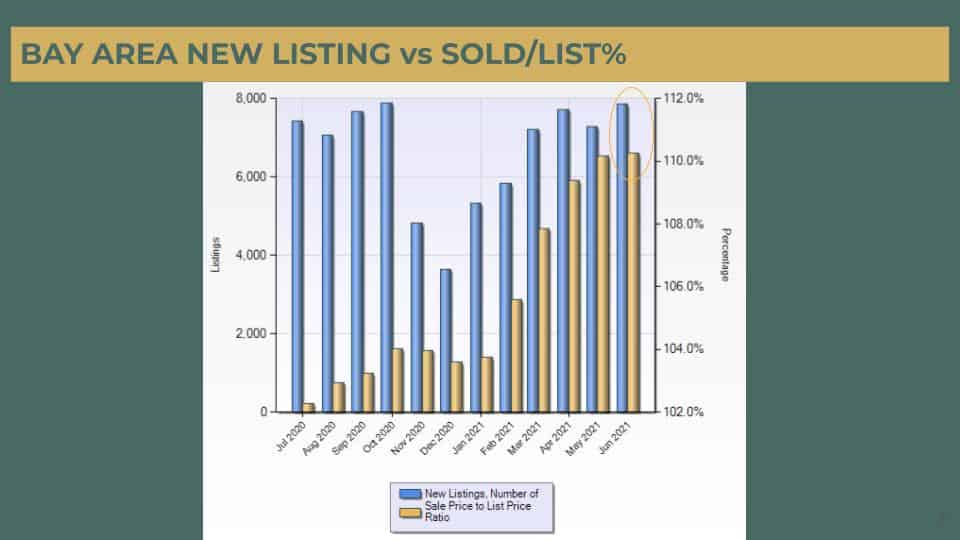
This chart shows the number of new listings to be added on the market versus sold price over list price ratio. Even though our inventory had gone up quite a lot since December, almost reaching last year’s level, people are making offers more aggressively. We went from just barely over 2% over asking price to now over 10% over asking price. That’s why last month we were just really overwhelmed, we have done a record number of deals just in the past six or seven months. So this is just to show you how much activity is out there on the market.
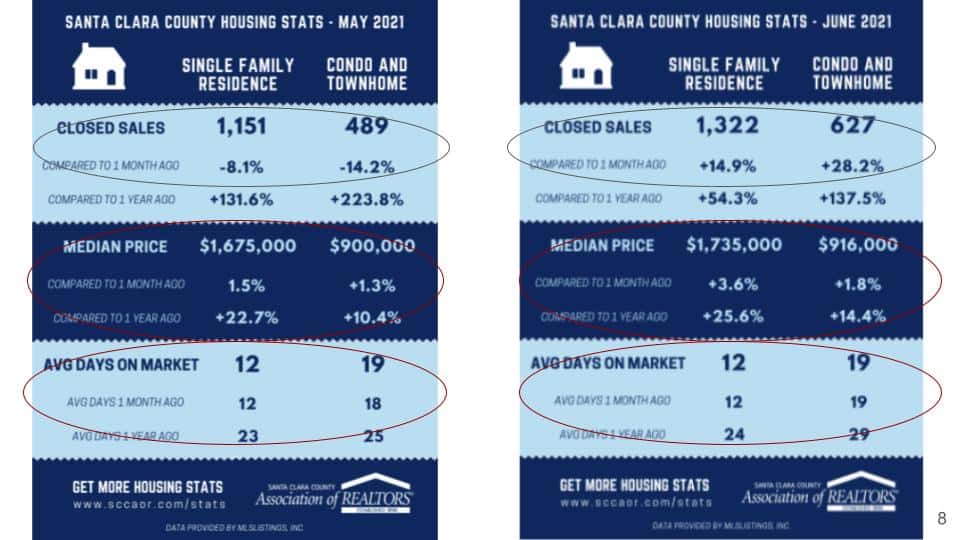
Let’s go back to look at Santa Clara County housing stats. If we compare May and June numbers, it went up 14.9% in terms of number of closed sales, and compared to one year ago, it was 54.3%. But bear in mind that at the time, we just reopened the real estate market because we shut down for a few weeks. The median sales price has gone up to $1.735 million and it has risen 25.6% compared to last year. While the average days on the market have gone down from 24 days last year to 12 days, and stay pretty consistent from last month. In terms of condo and townhome, we also have a lot more sales. It was 28% more from last month, and 137.5% more from one year ago. Their median sales price now is at $916,000, which went up 1.8% from a month ago, and 14.4% from a year ago. Average days on the market is not bad at all, it’s still only 19 days on the market, it has come down 10 days from one year ago.
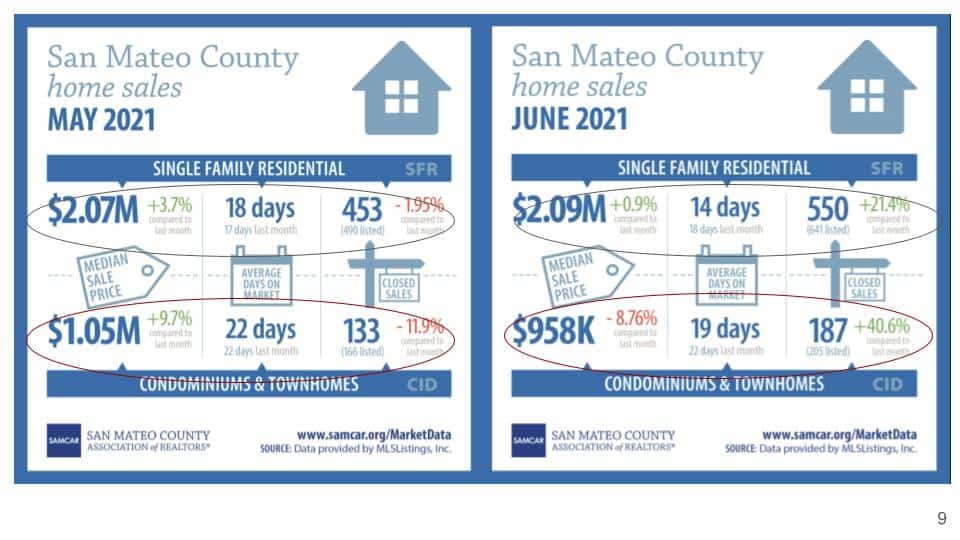
As for San Mateo County, you will see that for the single family residential side, the sales price has gone up to $2.09 million, which is up by about 0.9%, and it’s only 14 days on the market compared to 18 days last month. There were 550 close sales this month compared to last month’s 453, it has gone up 21.4%. In terms of the condominiums and townhomes, their median sales price was at $958,000, which actually went down about 8.76%. The average days on the market has gone down a little bit to 19 days versus 22 days last month. The number of closed sales is 187 while last month was only 133, so it went up 40.6%.
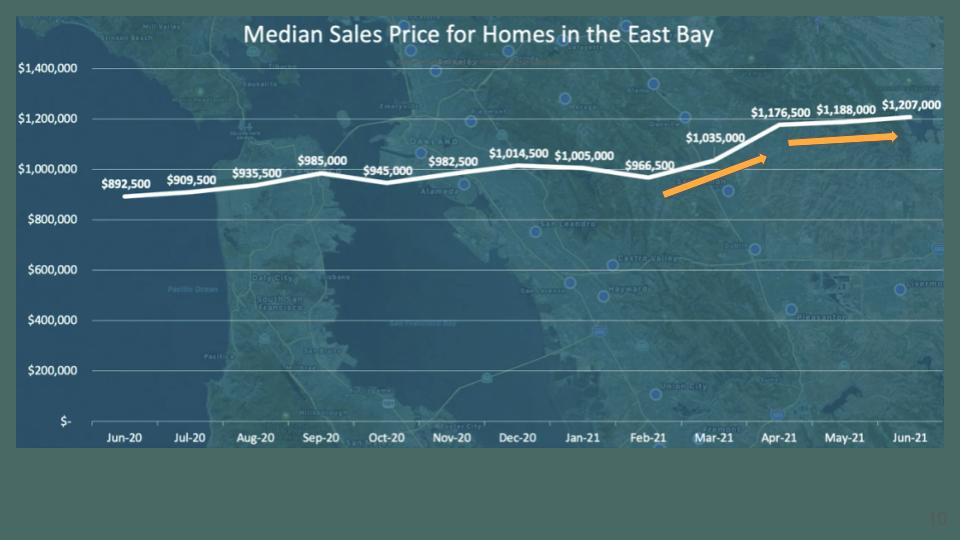
Let’s look at the East Bay. Last year the median sales price was around $892,000 and it has gone up. Now, it is at $1.2 million. It had gone up quite a bit since last year, but the steepest part was actually around February to March, and then it did slow down a little bit in terms of the appreciation, but definitely is still going up very strong.
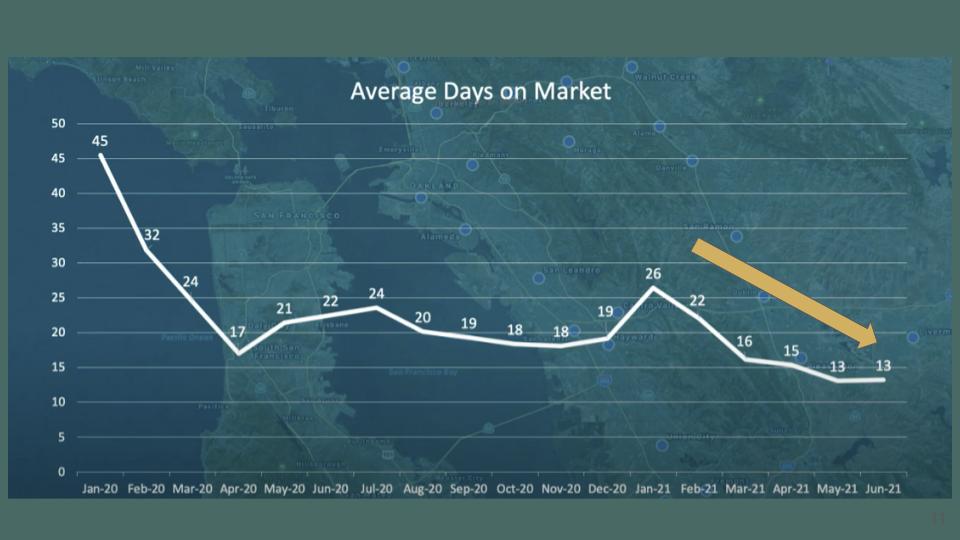
As for the average days on the market in the East Bay, as you see, last year in January it was 45 days on the market, and now down to 13 days. The pandemic had really shifted a lot of people from the Peninsula area to the East Bay, and we definitely have seen a drastic change.

Here, I’m just gonna show you real quick all these areas including 880 Corridor, Tri-Valley, West Contra Costa County, and Central Contra Costa. You see all these double-digit increases compared to last year, and I mean, this is not talking about in the teens, it’s about 40%, 34%, and these are huge numbers in the East Bay. I’m sure a lot of our East Bay sellers are very happy because the price has gone up so much since last year.

What happened to our open houses? Last month, our open houses reopened! You will start seeing more open house signs on the street. You know, one interesting thought is that do open houses really actually sell houses? For about 15 months, we did not have any open houses, but the market still remained very strong. Of course, there are a lot of buyers who still would love to go to open houses, so they can just go at their own convenience. Really, we see on average about 40 to 60 parties during the first weekend of open house for a listing, so it’s still a lot of people coming in to look at properties. So it is really fun now that we’re back doing open houses. It’s so fun to meet buyers and talk to them face to face, but of course, we still have to be careful. We still have to wear a mask when we’re indoors, and also control the flow as much as possible, but I think a lot of people are very excited that open houses are back.
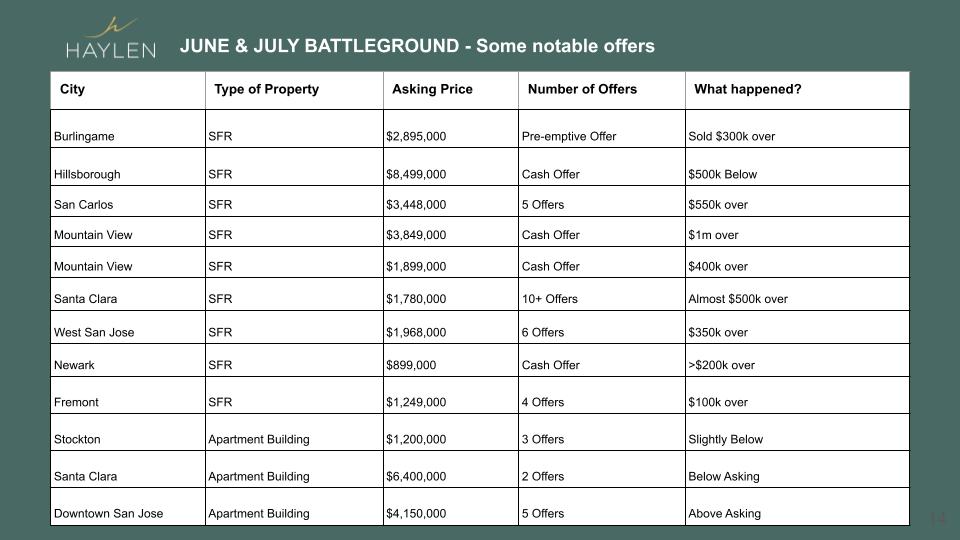
Now, we picked out a few real life offers that we have made or know of. We didn’t win all of them, but we want to show you what we know. As an example, in the Peninsula – Burlingame – single-family property asking price right under $2.9 million, got a preemptive offer, and sold $300,000 over. Hillsboro, $8.5 million cash offer, but went $500,000 below. So for a little bit high-end property, they do have a little more room to negotiate, it’s not as hot and go as crazy as the mid-range – I guess the mid-range here are properties about $2-3 million. San Carlos, asking $3.4 million, received five offers, and sold $550,000 over. Mountain View, as you see, all these cash offers, one was $1 million over, and another one is $400,000 over. Santa Clara and West San Jose, they also have multiple offers, still $300,000 – $500,000 over asking price. If we look at East Bay – Newark, Fremont, same thing, still getting cash offers, still getting multiple offers. In terms of apartment buildings, they are also getting multiple offers, although they are not all over asking price. Some of them are pretty conservative below, and we do see that even though there are multiple buyers, they are not as aggressive, and the offers are just right around asking price. We do see a few still try to get in below, and a few would go above. The apartment housing market is still going really strong, even though a lot of people are really worried about the eviction moratorium.
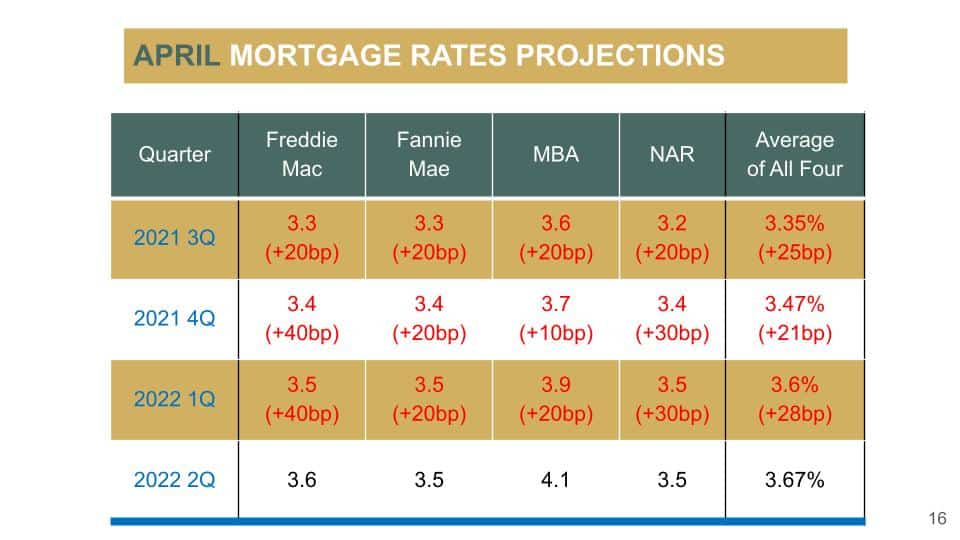
What about the loan situation? Let’s take a look at the mortgage loan situation. In May, we looked at the April mortgage rates projections, and I mentioned that from all these different organizations – Freddie Mac, Fannie Mae, Mortgage Bankers Association, and National Association of Realtors. They had all adjusted their projections and as you can see here, they adjusted about 20 basis points.
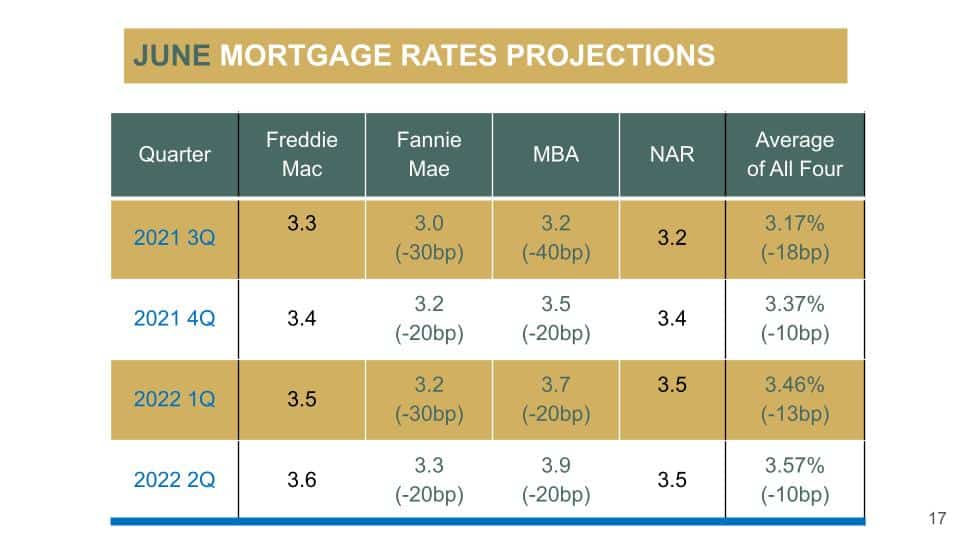
Let’s take a look at what happened now, Fannie Mae and Mortgage Bankers Association actually dropped their projections, they think the rates are actually going to come down more, it’s not going to be as high. Compared to the chart before, you see that for 2021, they thought it was going to be 3.3 – 3.6, now it’s like 3 – 3.2 for 3Q, and 4Q is about 3. If we average them out, it is 3.37%, and 2022 1Q is 3.46%, 2Q is 3.57%. Even though it is going up, the projection is definitely a lot more mild compared to what we thought it was gonna be. Freddie Mac’s and National Association of Realtors’ projections are remaining the same. I thought this is really interesting because for a few months now, we kept saying their projections have been going up, but this month actually has gone down, so it’s good news, but how will these projections or these rates affect our housing market? I think that’s something that we need to think about, too.
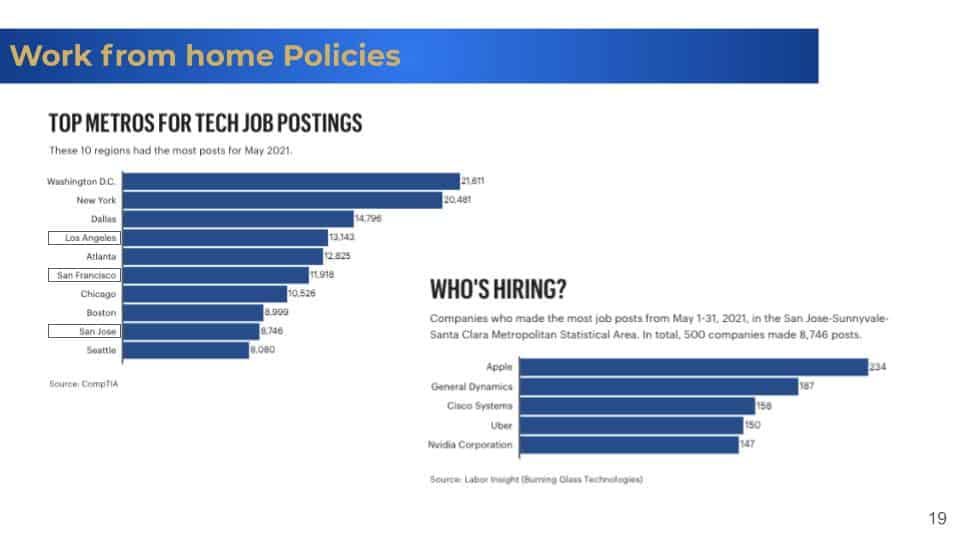
Now, a lot of people are asking – are people coming back to California or not? Let’s look at the top metros for tech job postings. Here, the top 10 regions with the most job postings in May 2021 are Washington DC, New York, Dallas, Los Angeles, Atlanta, San Francisco, Chicago, Boston, San Jose, and Seattle. Three out of those ten are all in California. Now, within Silicon Valley, Apple actually posted the most job postings in the Silicon Valley area, so what does that mean?
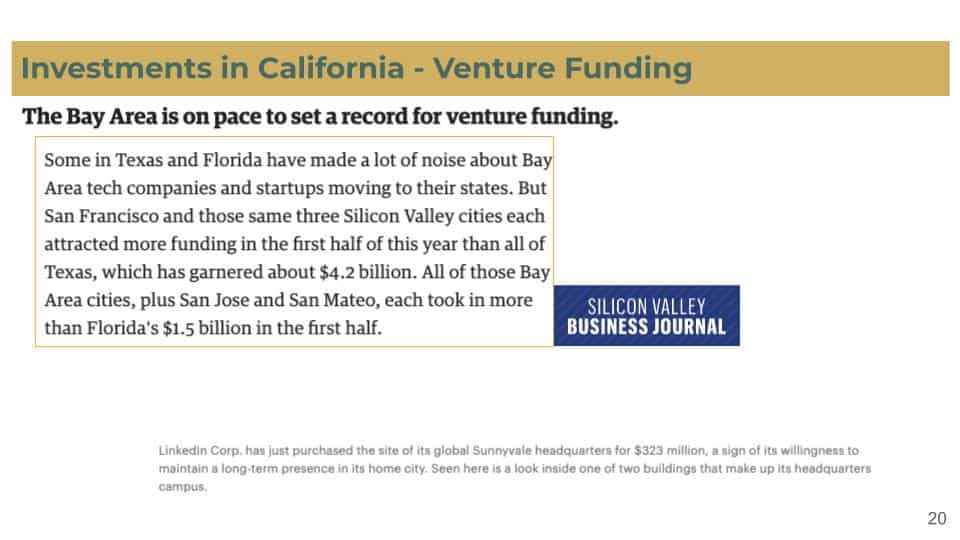
We also want to take a look at whether these companies are actually investing in California. The Silicon Valley Business Journal actually had an article – The Bay Area is on pace to set a record for venture funding. As a matter of fact, we have a few clients who are in the venture funding industry, and they told us the same thing. They are staying in, they also talk about how a lot of people have been talking about the California exodus, a lot of companies are moving out. But really, it’s such a small number of companies. As you see here, it says that “some in Texas and Florida have made a lot of noise about Bay Area tech companies and startups moving to their states. But San Francisco and those same three Silicon Valley cities each attracted more funding in the first half of this year than all of Texas, which has garnered about $4.2 billion. All of those Bay Area cities, plus San Jose and San Mateo, each took in more than Florida’s $1.5 billion in the first half”. It shows that there are still a lot of investments in California. I thought it was also very interesting that LinkedIn got out of this rental market, they actually went ahead and purchased the site of its global Sunnyvale headquarters for $323 million, so they are also investing locally in Sunnyvale.
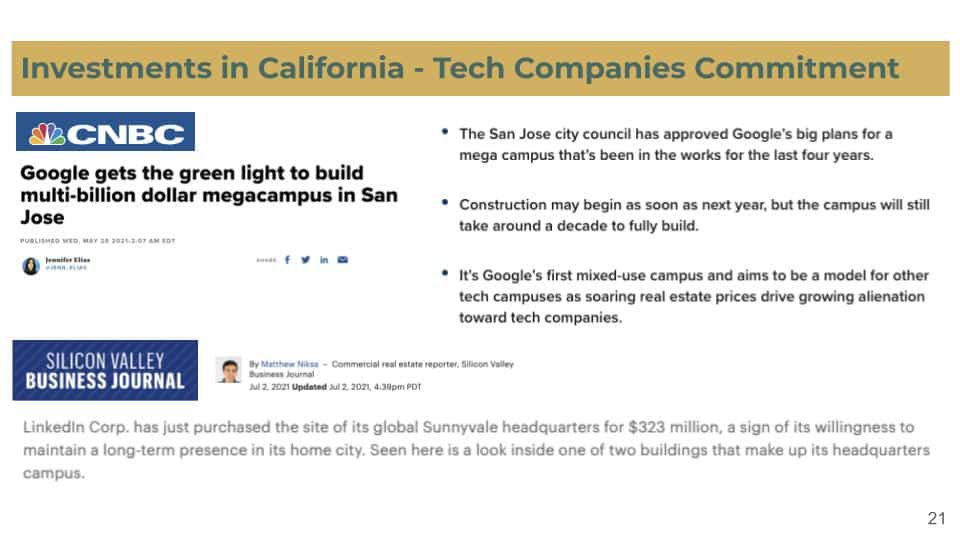
What about Google? Of course, they already got the green light, we know that back in May. San Jose city council has approved that big plan, and what does it mean? It actually is a multi-billion dollar mega campus. On top of that, we mentioned just now that LinkedIn also has purchased properties here for their company.
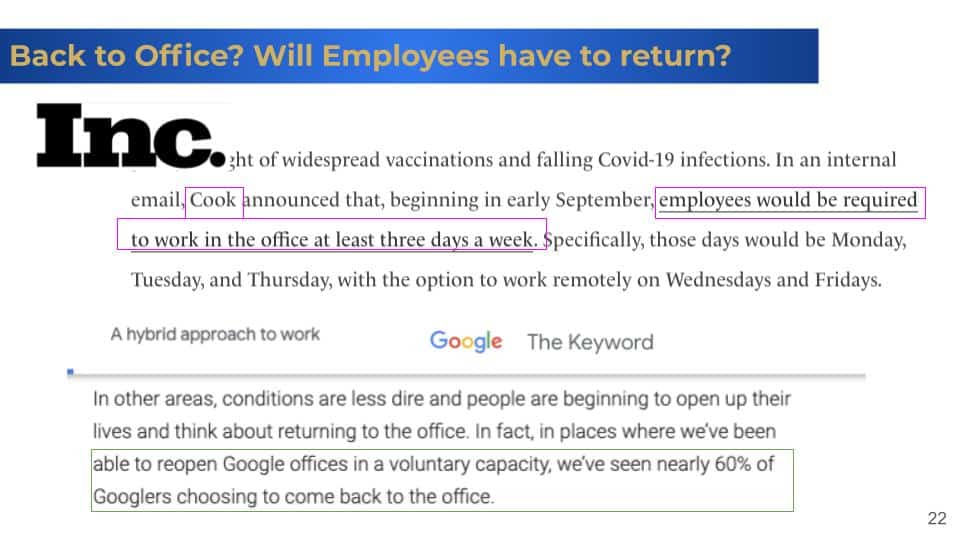
Now, do you think they’re going to keep their employees in the office or let them work remotely permanently? If you look at the article for Apple, Tim Cook had announced that “beginning in early September, employees would be required to work in the office at least three days a week”. With this schedule, even though it’s hybrid, most people who work for Apple will have to move back to California if that’s their requirement. Also, Google said the same thing. They “have seen nearly 60% of googlers choosing to come back to the office”.
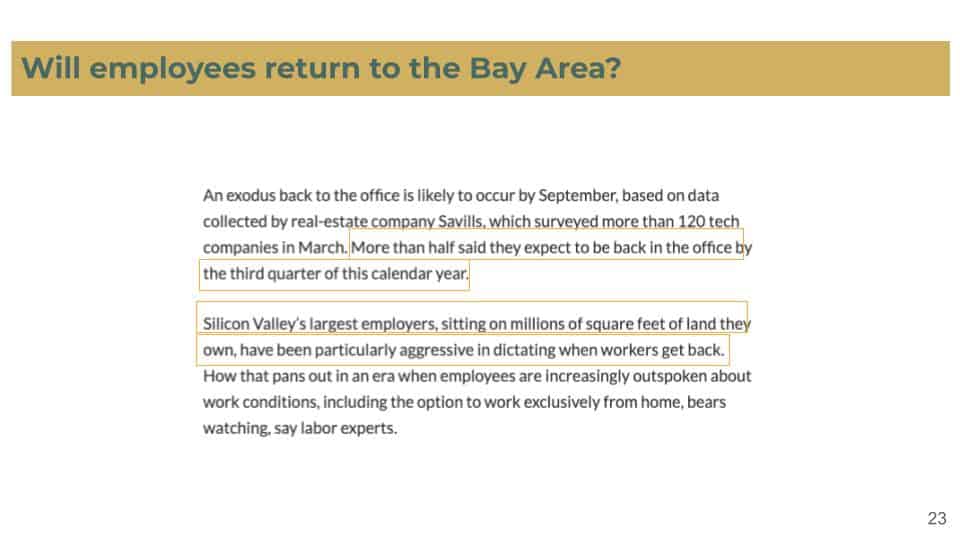
We also look at this report which surveyed more than 120 tech companies in March, and they said that more than half said that they expect to be back in the office by the third quarter of this calendar year, which is very much in line with what Google and Apple, who are telling their employees to be back into the office in September. “Silicon Valley’s largest employers, sitting on millions of square feet of land they own, have been particularly aggressive in dictating when workers get back”.
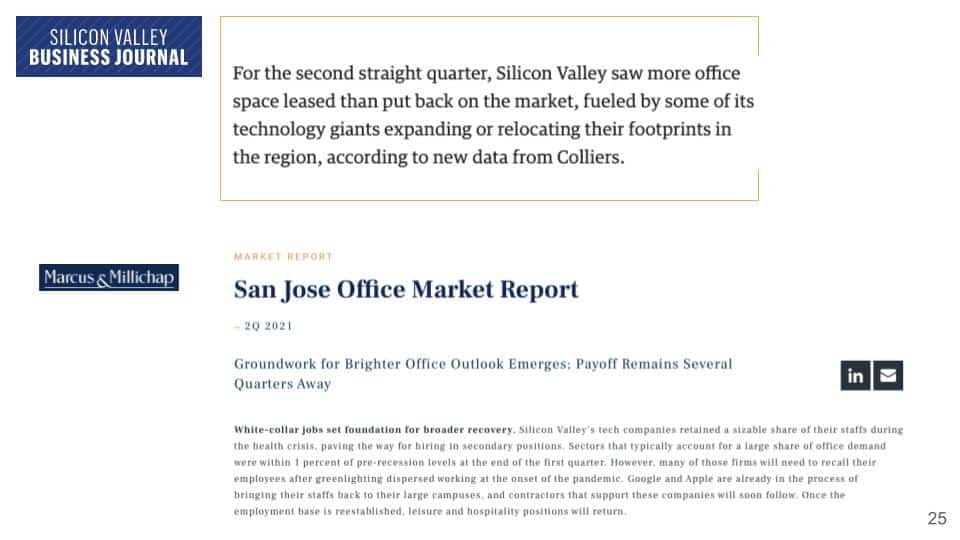
With that said, let’s look at the office market. Since people are coming back, we do see more people are leasing in the office market. As we know, the office market was very quiet even until April, and all of a sudden around mid-April, we do see a lot of companies coming back out and starting to prepare and look for office buildings to buy or to lease.
The Silicon Valley Business Journal again says that “for the second straight quarter, Silicon Valley saw more office space leased than put back on the market, fueled by some of its technology giants expanding or relocating their footprints in the region, according to new data from Colliers”. Marcus & Millichap also have their report for 2Q 2021. They talked about pretty much the same thing: “Groundwork for brighter office outlook emerges”. We definitely now see that the office market is coming back alive.
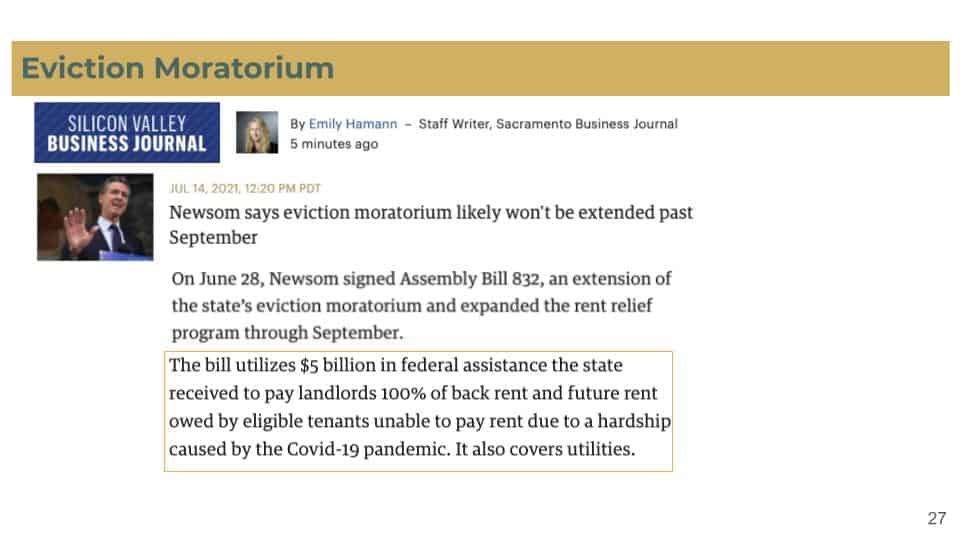
With that said, companies are now opening back up, they’re investing here, they’re leasing more, they’re buying more, and they’re requiring employees to come back. What will happen to the rental housing market? Of course, the biggest topic for the rental housing market has been the eviction moratorium. It was supposed to expire back on June 30th, but they have extended it again and again, now, it has extended until September. With this newsom assigned Assembly bill 832, the eviction moratorium is extended until September, but the bill also “utilizes $5 billion in federal assistance the state received to pay landlords 100% of back rent and future rent owed by eligible tenants unable to pay rent due to hardship caused by the Covid-19 pandemic. It also covers utilities”. Right now, it’s only 80%, and I know 100% is definitely a huge help, although still, it’s not the best scenario for a lot of landlords, I think if they are able to cover 100% of the back rent and future rent, it will be such a relief for these small landlords who have been just really paying out of their own pocket for all these expenses, so I’m very excited to hear that. Hopefully, you know, we are going to go back to the normal market soon knowing the job market has improved so much.
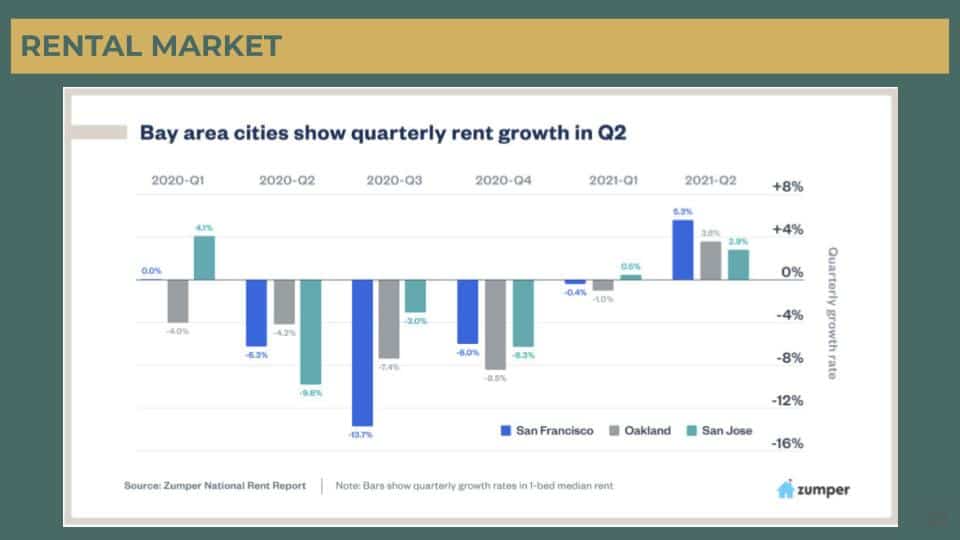
In terms of the rent growth, we see that during Q2 2020, it went down quite a bit. Now 2021 2Q, the rent has gone up for San Francisco, Oakland, and even San Jose area.
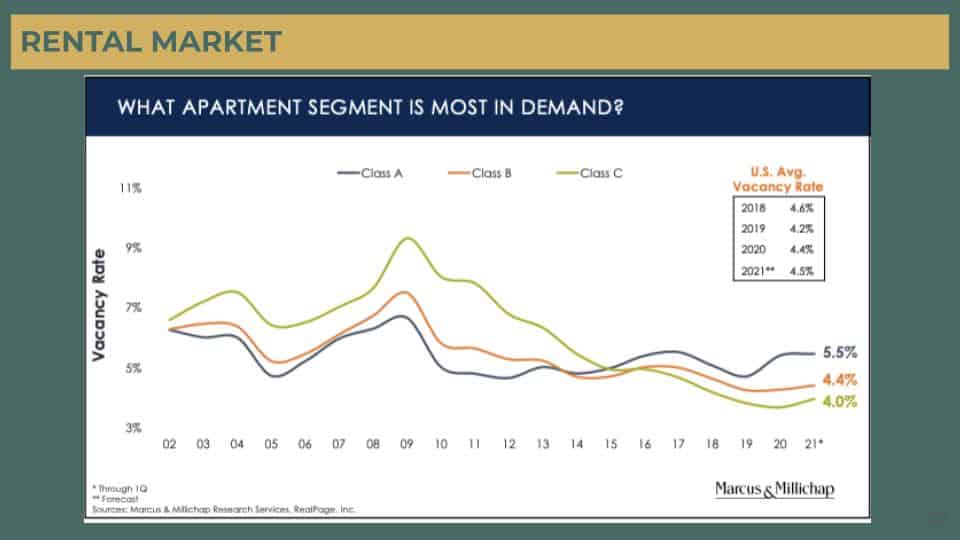
What apartment segment is the most in demand? If you look at the vacancy rates, this report actually was produced in 1Q, so it was more of a projection. It shows that in 2021, we should see the vacancy rate at about 4.5%. Here, as you can see, the Class C vacancy rate is the lowest at 4%, Class B is at 4.4%, and Class A is at 5.5%.
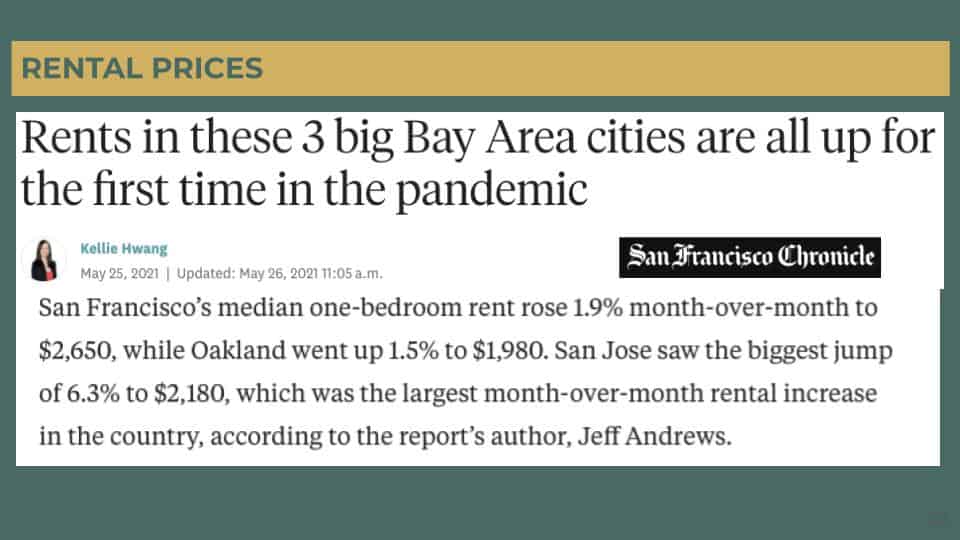
The rents in three big Bay Area cities are all up for the first time in the pandemic. We’ve been talking about how the rent has come down, but remember, if the rent comes down 25%, it will take a lot more than 25% to come back up to the previous level, of course, but at least it’s good news. “San Francisco’s median one-bedroom rent rose 1.9% month-over-month to $2,650, while Oakland went up 1.5% to $1,980. San Jose saw the biggest jump of 6.3% to $2,180, which was the largest month-over-month rental increase in the country, according to the report’s author, Jeff Andrews”.
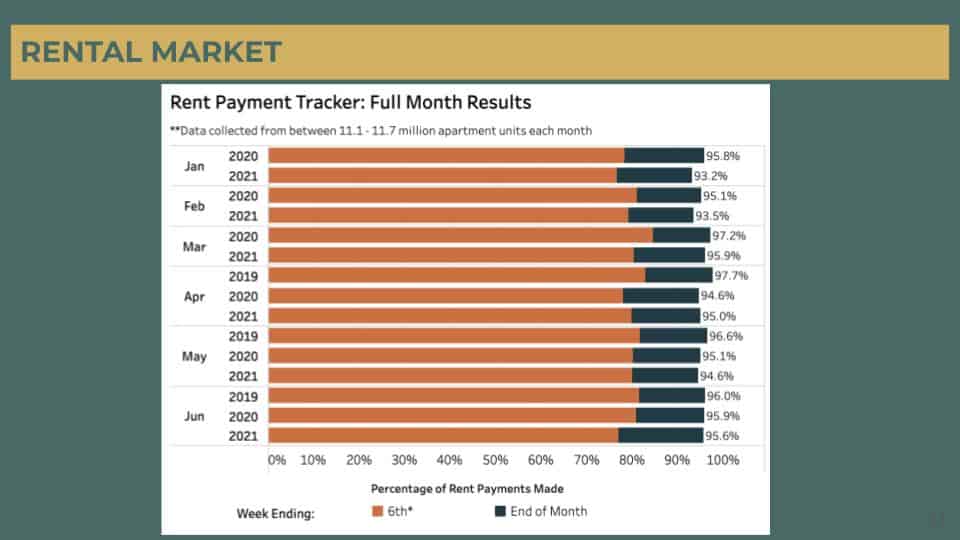
Here’s the rent payment tracker. We are still around 95% – 96%. It is still not as high as back in 2019, and it’s slightly worse than 2020, as a matter of fact. But that’s also because back in June, at the beginning of the pandemic, people might still have some savings. At this point, we do see that there is some lingering effect that some of the renters cannot pay. Also, the brown side is talking about how much people pay by the 6th of the month, we actually have a lower number compared to most of the previous months.
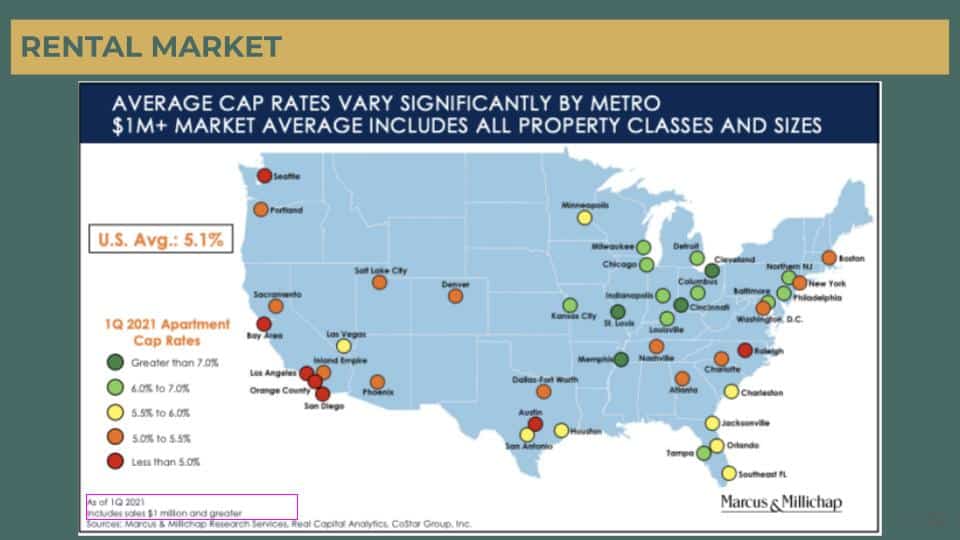
I thought this would be a fun chart for those investors who are looking throughout the whole country wanting to see the cap rates. The dark green ones are the ones that you can still find cap rate over 7%, while the lighter green is 6-7%, yellow is 5-6%. Although I actually have seen a lot of properties in Texas, really, I don’t think I see anything 6% unless it’s Class C area possibly. In the Bay Area, of course, we’re still seeing 3% for apartment buildings.

Here’s the forecast for housing by Pulsenomics. Their prediction is that in 2021, the appreciation is about 8.66%, this is the national average. In 2022m it will start to be more mild – 5.12%, then 2023 to 2025 will be in the 3% or so.
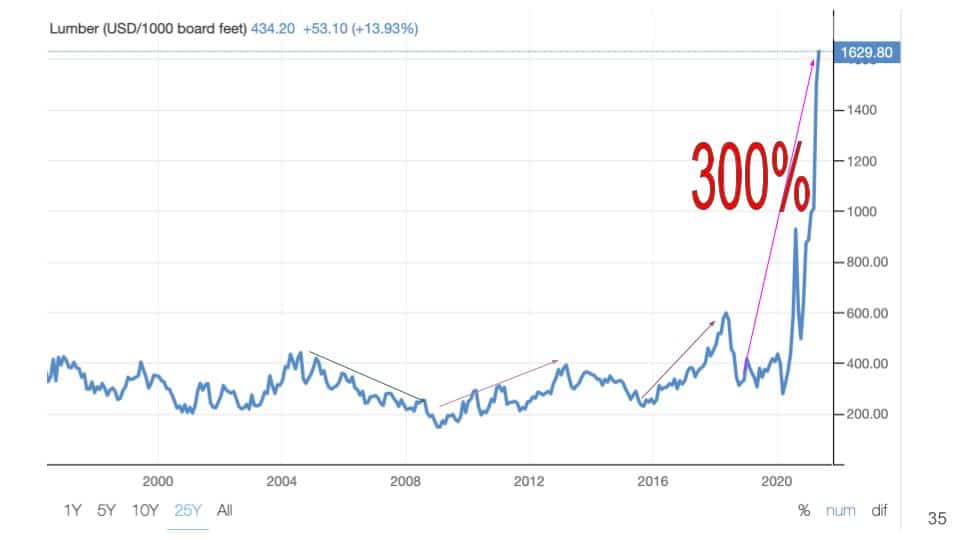
I want to touch on a little bit about the lumber. We talked about last time that the lumber price has gone up 300%, which is pretty significant.
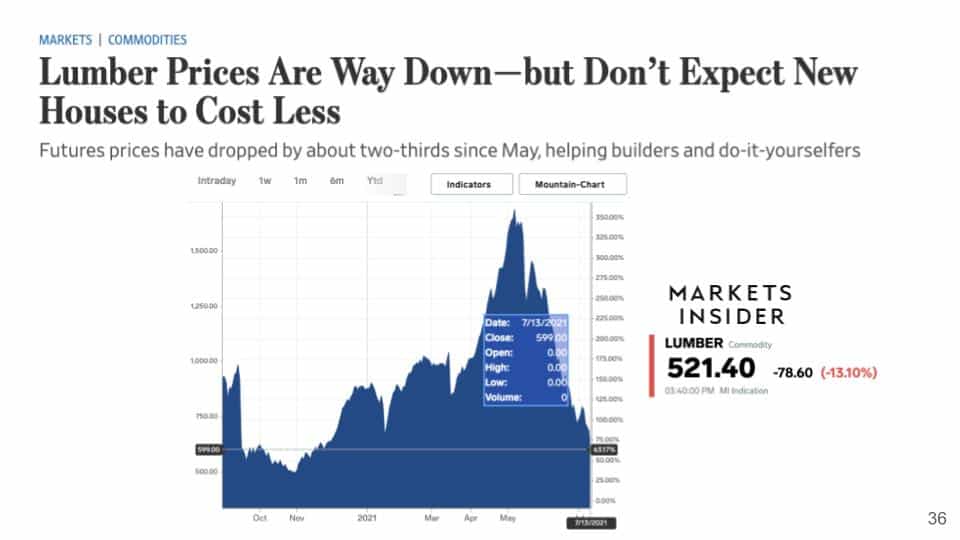
But interestingly, if we look at what happened just last week, the lumber prices had dropped significantly. You see it went up 350% and then back down, so it actually has gone down quite a bit. However, it doesn’t mean that the housing price is gonna come down. They actually don’t expect the new houses to cost less, but the builder is definitely going to start stocking a lot more lumber now and start to build more.
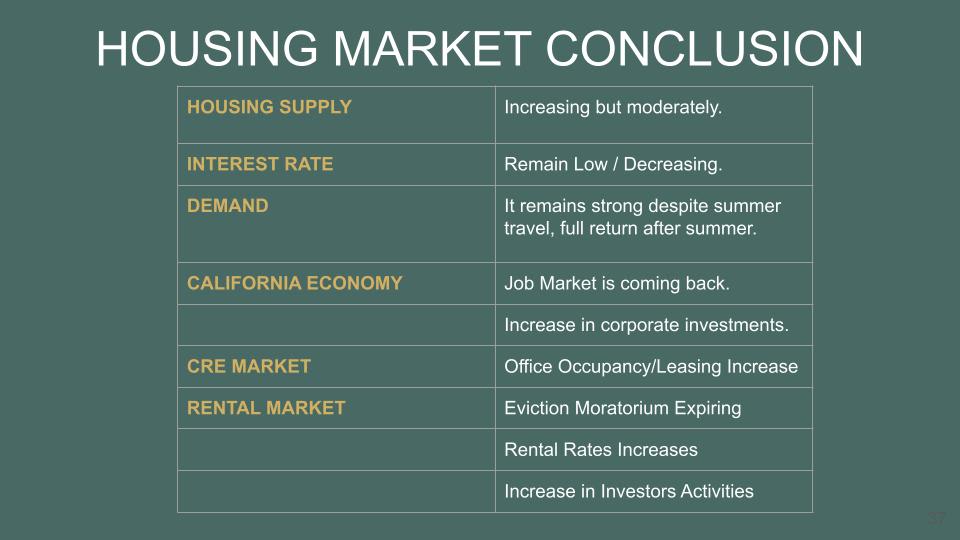
In conclusion, we’ve looked at the housing supply, we’re going to see it start to increase, but moderately. Interest rate is going to remain low, the projection has decreased, so it will still remain pretty low. The demand is still really strong, as we mentioned, there are summer travel plans, but we still had a lot of people coming to open houses. It is probably going to have a full return after the summer break. The California job market is coming back, and we have an increase in corporate investments, so our economy is doing great. In the commercial real estate market, we see office occupancy and leasing activities going up, so it’s showing that more and more people will need to come back to California. With the eviction moratorium expiring, rental rates increase, you’ll see that we’re going to have even more investor activities on the market.
As we expect to see more investor activities in the real estate market, for the July Bay Area Housing Market Townhall webinar, we invited experts to share with us some of the most overlooked tax-saving strategies for real estate investors. Watch the webinar recording here! As always, please don’t hesitate to get in touch with us if you have any questions, comments, or other topics you would like to discuss.
Stay up to date on the latest real estate trends.
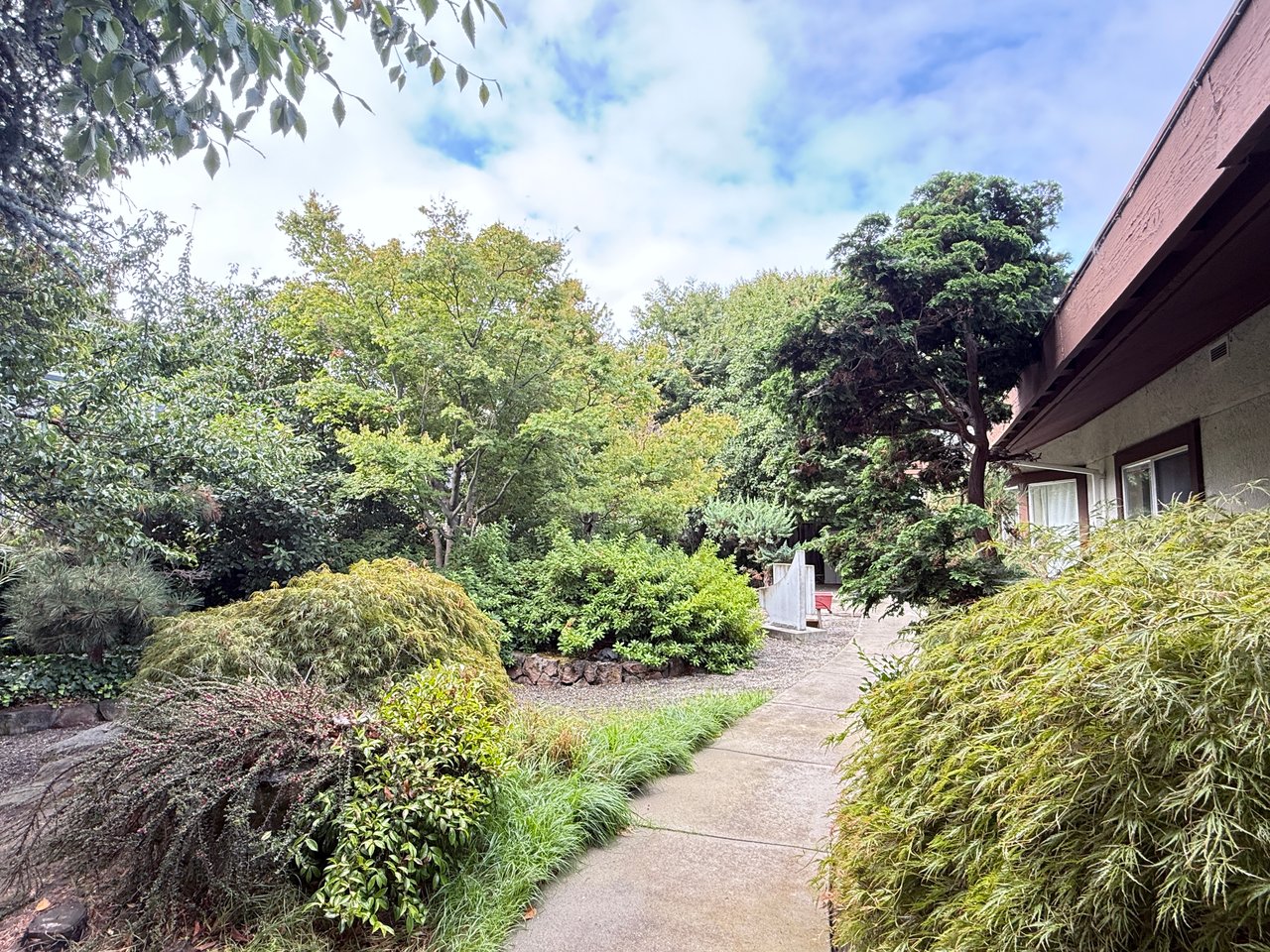
HAYLEN was selected for its culturally aligned, people-first advisory approach, supporting the Nikkei-rooted organization through a values-driven real estate transition





You’ve got questions and we can’t wait to answer them.